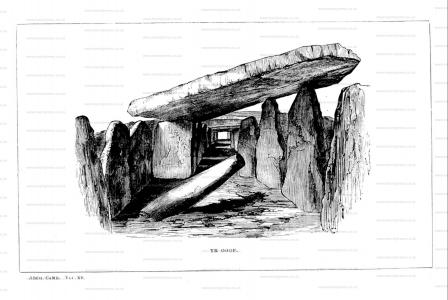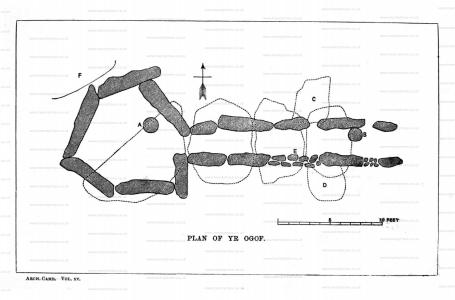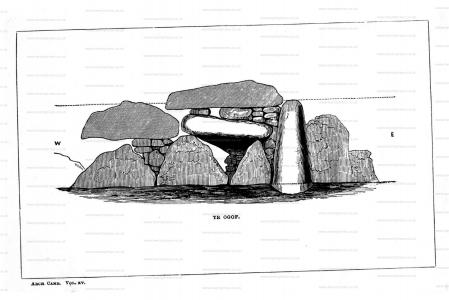Archaeologia Cambrensis 1869 Page 118 Cromlechs in North Wales
Archaeologia Cambrensis 1869 Page 118 Cromlechs in North Wales is in Archaeologia Cambrensis 1869.
None of the cromlechs that have been briefly mentioned seem to have traces of galleries leading to the chamber. This, as is well known, is one of the marked distinctive features of sepulchral chambers in Britany, as contrasted with those of this country. In the former country they are by no means uncommon; in the latter, particularly as regards Wales, they are extremely rare. Allusion has been already made to the gallery connected with the three chambers near Capel Garmon. Through the courteous kindness of Capt. Lukis we are enabled to present a copy of the plan made by that gentleman, accompanied with careful and accurate measurements of details (cut 12), of the chamber of Bryn-celli Ddu [Map], or, as it is called in the Ordnance Map Yr Ogof, or the hole or cave. It still retains some portion of the original carn, but is more remarkable from its having the greater portion of the original gallery leading to the chamber, in a tolerably perfect state. A view of the exterior of the chamber, showing the remains of the cairn and gallery together with an accurate description of the whole monument will be found in the Archæologia Cambrensis of 1847 (p. 3). Rowlands, in his Mona Antiqua, merely describes the remains of two carns near each other, one of which had been almost in his time entirely removed, and the other had been broken and pitted into on one side. "Two standing columns" are also said to exist between the two carns. (Mona Antiqua, pp. 93, 100.) An extremely rude representation is also given, which represents the carns as composed of nothing but stones, without any admixture of earth, which was not the case. As Rowlands says nothing about the gallery, it is more than probable that although the carn had been "pitted into" on one side, the gallery had not been discovered,— much less the chamber. While Pennant described it, one of the carns had vanished. At least he writes as if only one existed at the time. The upright stones are also passed over without notice, and were also probably no longer in existence. On the other hand, the late Miss Lloyd, in her account of the parish of Llanddeiniol Vab, in which the monument stands (see History of the island of Mona, p. 221), says, "At Bryncelli are some traces of large carneddau, where two upright stones are still standing."
But her not mentioning the chamber and gallery, the account of which by Pennant must have been known to her, would tend to show that she merely obtained her information from Rowlands, and had forgotten Pennant's description. Her History of Mona was printed in 1832. Pugh, in his Cambria Depicta, published in 1816, appears to have visited the chamber, but does little more than repeat what Pennant had previously stated.



The statement, as given by him (vol. ii, p. 272, ed. 1784), is as follows: "A few years ago, beneath a carnedd similar to that at Tregarnedd, was discovered, on a farm called Bryncclli-ddu, a passage 3 ft. wide, 4 ft. 2 or 3 ins. high, and about 19½ ft. long, which led into a room about 3 ft. in diameter and 7 ft. in height. The form was an irregular hexagon, and the sides were composed of six rude slabs, one of which measured in its diameter 8 ft. 9 ins. In the middle was an artless pillar of stone, 4 ft. 8 ins. in circumference. This supports the roof, which consists of one great stone near 10 ft. in diameter. Along the sides of the room, if I may be allowed the expression, was a stone bench, on which were found human bones, which fell to dust almost at a touch." Such is the statement; but unfortunately it is not certain that Pennant speaks of having seen what he decribes. He did visit Tregarnedd, in Llangefni parish; and his account of the chambered mound, which gave its name to the farm, seems to have led him to mention the somewhat similar chamber at Bryncelli-ddu. He may, however, have seen it on some former occasion; but whether this is the fact or not, it may be assumed with some degree of certainty that he would not have thus minutely described the chamber if he had not assured himself of the correctness of the information which had been given him.
This propping the capstone is very remarkable; but another example of such supplemental support may be seen in the great cromlech at Plasnewydd [Map], the enormous capstone of which seems to have made it necessary to place an additional supporter at an angle so as to meet the outward thrust. This, however, must have been done before the chamber was covered up by its mound; whereas in the case of the Bryncelli-ddu chamber, there is no reason why the pillar might not have been introduced after the entire completion of the monument, carn and all. Capt. Lukis states that there is a second pillar-stone at the eastern end of the gallery, which, strange to say, seems not to have been noticed by other observers; not even by the author of the excellent account given in the Arch. Camb., before mentioned; and is certainly not there at present. It is evident that, to whatever use the pillar in the chamber was applicd, that in the gallery must also have been put to the same; but what that use was, is doubtful, according to the opinion of Capt. Lukis, who has kindly placed at the service of the Association his notes on the subject:
"I have had another day at the cromlech of Yr Ogof, or "the cave"; and on the right side of the chamber, near the singular stone pillar which is within the area, I found a rude pavement of flat slabs; and immediately beneath it was a thick bed of small beachy pebbles, about 2 ft. in thickness,—at least the side-props seemed buried in it to that depth.
During the operation I found no pottery; but a few fragments of lead, which I consider as having been thrown there accidentally; and a good deal of charcoal, a broken flint-knife, a javelin-head, and some few bits of human bones.
"I then measured the extraordinary stone-pillar, which was in a slanting direction towards the south, and I found it to be exactly 9 ft. in length, with a circumference in its thickest part (for it tapers upwards) of 14 ft. 10 ins. This leaning pillar bore evidence of its having been disturbed at the base, on the southern side; but I do not conceive that when in its proper upright position, it could have touched the under surface of the covering stones.
In reasoning on the singularity of this pillar within the principal chamber, so very unlike the other props of construction around the place, it cannot be considered to be for the purpose assigned to stone-pillars, as supports, which are sometimes found in other cromlechs. In the structure of Déhus, in the island of Guernsey, the rude pillar beneath the second capstone was evidently placed therein to support a flaw or crack which was found to endanger that covering stone. Again, in the cromlech at Carnac, in Brittany, the capstone was found to be too short, and it became necessary to support it by an additional side-prop. Other cases might be adduced where internal supports have been placed; but in all these instances the intention and the reason- ing of the cromlech-builders are clear and evident. All these supports are equally rude, unwrought props for a necessary purpose.
At Yr Ogof we find a pillar with a regular abraded surface, almost polished in some parts, and gradually reduced upwards. The character of this pillar is so different from those on record, that we are forced to assign some other reason for its introduction into the main chamber.
"In the accompanying plan of the structure it will be seen that another abraded pillar stands at the eastern end of the avenue covered way. It is more rude and irregular than that in the chamber; and it stands near a small side-cist, which appears to be an addition to the chief cromlech. The character of these two pillars must be considered as having a design entirely different from those we have discovered in other cromlechs.
"To enter largely into the religions which prevailed over the world in the infancy of man, would lead us to a lengthy chapter far beyond the limits of this Journal; but we cannot avoid being struck by the strong religious feelings which the cromlech-builders possessed in cone triving these strongholds for the security of their dead bodies. I can only say that the pillars at Yr Ogof assimilate greatly with the styles of the Hindoo, although there may be some deeper meaning in placing them within the chamber of the dead."
Then follows a sketch of an altar erected to Siva or Mahades, which was found in a grove not far from Allabahad, on which were placed five stone celts (now in the possession of Capt. Lukis); and as those imple- ments are so frequently found in our own cromlechs and cists, he thinks there may be some connexion of Eastern metaphysical speculations with those which may at one time have prevailed in our country. The altar is rectangular, built up of square stones surmounted by a thin slab, from the centre of which rises a short stilus against which leant the five celts, although only three of them still retained that position at the time of the visit.
Now, although any opinion on cromlech questions emanating from a member of the Lukis family will be received with due consideration and respect, yet serious objections to his views as regards the present case will at once suggest themselves to most minds, as they have probably occurred to him himself. 'L'he principal reasons given by Captain Lukis, that these pillar stones were not intended for props, are, that the other arranae- ments for giving additional support which have come under his cognizance elsewhere are totally dissimilar, that these pillars have been curiously abraded and almost polished, and lastly, that the one in the chamber is too short to have reached the under surface of the capstone. The last of these objections is easily re- moved; for even supposing that the level of the floor is the original one, yet it would be more easy to fix by means of wedges a prop which is rather shorter than the space between the ceiling and the floor. The same thing is done every day, when it is necessary to give the same kind of support to the beam which supports the upper part of the wall of a house while the lower part is being removed. The props are more securely and efficaciously applied by means of wooden wedges driven underneath them. It is true that when the lower wall is replaced, the props are removed, but the principle is the same. Stone wedges would have been of course used instead of wooden ones, and even according to Captain Lukis's account there appear to be certain indications at the base as if the stone itself had been curtailed at this end; and it is not improbable this appearance may have been caused by the action of the stone wedges. It is curious that one of the pillar- stones bas been worked, and even polished. This polishing might indicate that it is of later date than the chamber itself; and as it is certain, as will be presently seen, that this has been the burial-place of more than one, and may have been in continued use for generations, it may be fairly suggested that, in course of time, the security of the capstone of the chamber being doubtful, the precaution of thus propping it up was taken, long after the first construction of the chamber. But whether these replies to Captain Lukis's objections are considered satisfactory or not, there is still the evidence of Pennant to be set aside, as regards the use and object of the pillar. In addition to all this, it might fairly be asked, is there any instance known of anything like a stylus, found in any of the chambers have of late years been carefully exa- mined by competent persons, as is the case more parti- cularly in Britanny. Nothing, we believe, of the kind has been ever found or even looked for. It is true that magnificent discoveries of stone implements have been made; but these cannot be considered as in any way connected with any Eastern or other mysticism, being simply the implements and ornaments placed by the body for use in its future state of existence; or, when they are found purposely broken, as is frequently the case, simple tributes of affection and respect, as if such articles were too precious to be ever used again. Independently, therefore, of what Pennant has told us, most will probably consider these stones (if there are two) as simple pillar-props, and in no way connected with any religious or other superstition.
No traces remain of the stone bench once running round the chamber, on which were said to have been placed bones, which crumbled soon after their discovery. Unfortunately, no record of the opening of the chamber has been preserved, and the account given by Pennant does not intimate whether the bones had been burnt or not.
The gallery which led to the chamber, measured in 1847 about eighteen feet, while in Pennant's time it was nearly twenty feet. As, however, he does not allude to the two side cists or small chambers on each side of the eastern extremity of the gallery (see Plan No. 12) it is likely that he did not examine. the structure himself. They may, however, have as easily escaped his notice as they seem to have done that of the writer in the Archaologia Cambrensis. The fact is, that the traces of them, especially of that on the south side of the gallery, are so faint that they are with diffculty made out by an unpractised eye. By some its very existence is doubted. Some thirty or forty years ago, however, one of the ser- vants at Dinam remembers playing up and down the then tolerably perfect carn with his playfellows, the boldest of whom would occasionally enter the chamber itself. His impression is that these chambers existed as is laid down by Captain Lukis in his plan.
These additional chambers prove beyond doubt, that this carn (and probably the other which once stood beside it) was one of the burial-places of the district for a considerable period. Miss Lloyd mentions, in confirmation of this, that there were numerous remains of cromlechs in the adjoining fields. We have innumerable proofs how constantly the burial-places of the earliest races were called into requisition by succeeding races, so that centuries, in some instances, have intervened between the earliest and latest deposits. Unfortunately, no record has been kept of the remains found of the Bryncelli carns, and but for the accidental preservation of the ruins of one of them, no evidence at all of secondary interments would have existed.
That such was the practice in Wales, as elsewhere, admits of little doubt, although the general destruction of monuments of this class has left so few means of proving it. Nothing,however, is more natural, and there- fore more probable, than that men would make use of convenient receptacles for their dead, which they found ready made for them, rather than (except under especial circumstances) undertake the cost and labour of con- structing such mounds and chambers. Although, there- fore, there is no actual necessity that proofs of such a practice should be brought forward, as will be found collected in Ten Years Diggings, yet the existence of the side chambers at Bryncelli is of some importance as confirming what might have been concluded from à priori reasoning.
The accompanying views of the interior and side view (Nos. 13 and 14), are also from the pencil of Captain Lukis, and will convey a most accurate notion of the character of the existing structure to those who have not had an opportunity of examining the original. The whole is surrounded by a wall erected many years ago by the late Mr. C. Evans of Plas Gwyn, but for whose inter- position, it is probable, that the whole would have been by this time swept away. As already mentioned, living men remember the present ruin a high mound of earth and stones overgrown with blackthorn, the sloes of which they gathered in their younger days, so that the work of destruction must have gone on with activity, as it is at least a quarter of a century since Mr. Evans came to its rescue and saved it from annihilation.
E. L. BARNWELL.

